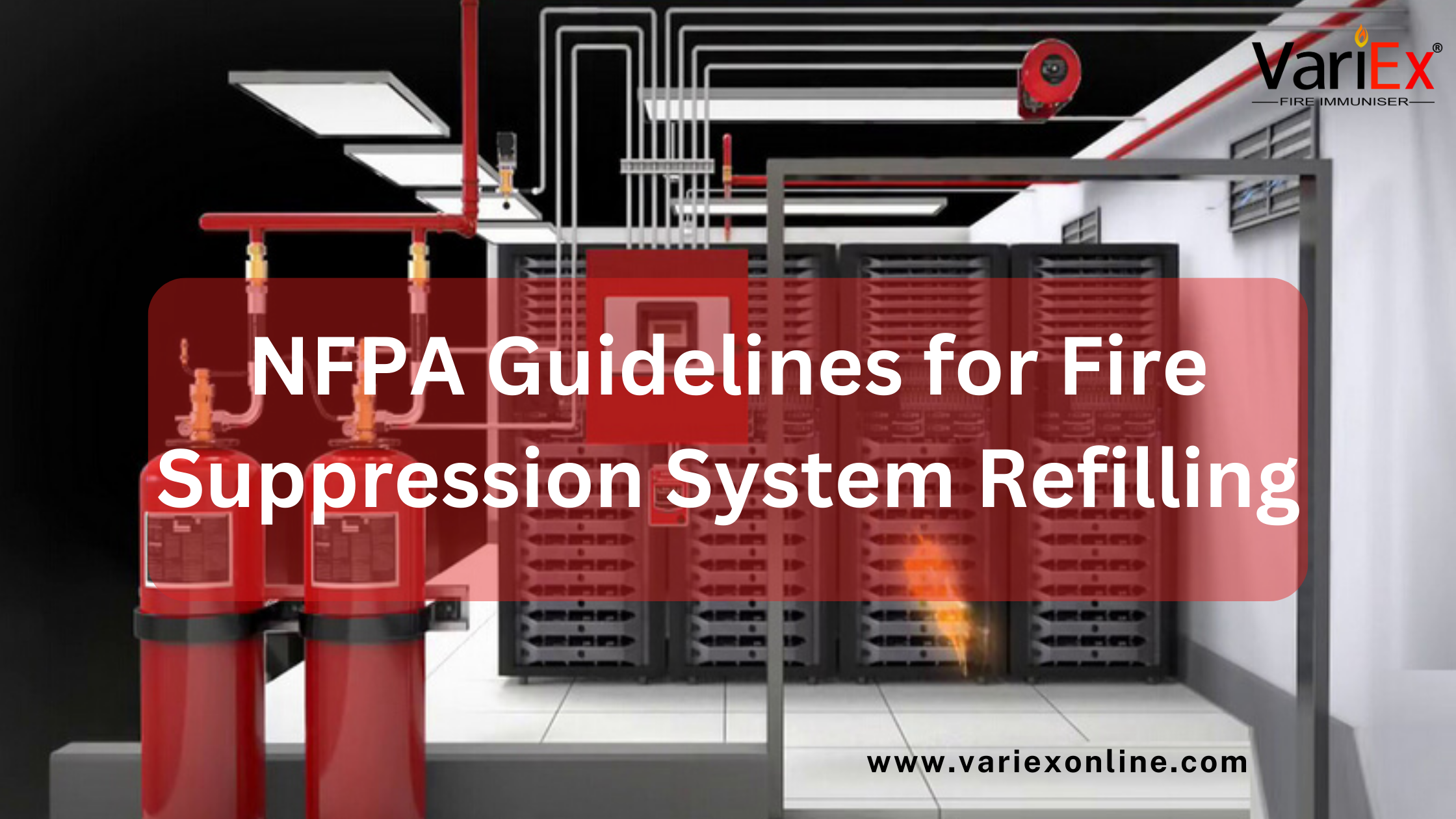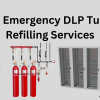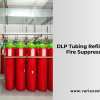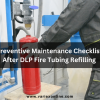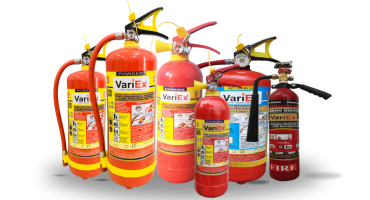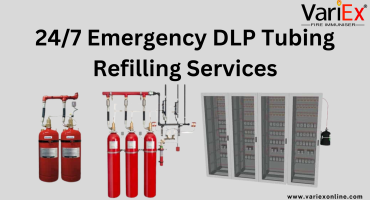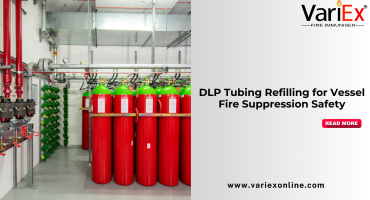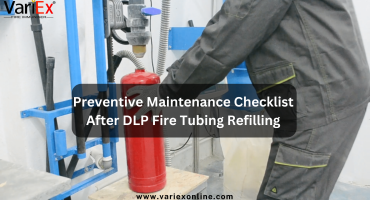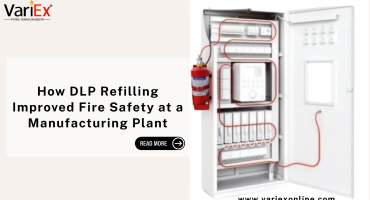![]()
Fire Immuniser
+91-7829629111
Email: info@variex.in
Varistor Technologies Pvt. Ltd.
Block-1, First Floor, Ardente Office One, Hoodi Circle, ITPL Main Road, Bengaluru, Karnataka 560048, IN
NFPA Guidelines for Fire Suppression System Refilling
NFPA Guidelines for Fire Suppression System Refilling
A fire suppression system is only as reliable as its last refill. Refilling isn’t just a maintenance task — it’s a life-saving requirement governed by strict standards. Following the NFPA (National Fire Protection Association) guidelines ensures your fire suppression system stays operational, compliant, and ready for emergencies.
In this comprehensive guide, we’ll explore the NFPA standards, critical refilling steps, key compliance requirements, and best practices you must follow to avoid costly mistakes and keep your building safe.
Why NFPA Guidelines Matter for Fire Suppression Refilling
-
Consistency: Ensures refills are performed uniformly across facilities.
-
Safety: Minimizes system failure during real emergencies.
-
Compliance: Prevents fines, insurance issues, and legal problems.
-
System Longevity: Protects your equipment and extends service life.
Ignoring NFPA requirements can result in significant safety risks and financial penalties.
Relevant NFPA Standards for Fire Suppression Refilling
| NFPA Standard | Focus Area | Key Application |
|---|---|---|
| NFPA 12 | CO₂ Fire Suppression Systems | Refill and maintenance after use or leakage |
| NFPA 17 | Dry Chemical Fire Suppression Systems | Refilling procedures for kitchen and industrial systems |
| NFPA 17A | Wet Chemical Fire Suppression Systems | Refilling wet agents in kitchen fire systems |
| NFPA 2001 | Clean Agent Fire Suppression Systems | Guidelines for gaseous suppression agent refilling |
| NFPA 10 | Portable Fire Extinguishers | Inspection and recharging instructions |
Each standard outlines specific requirements for inspection, maintenance, and agent replacement.
Key NFPA Refilling Requirements
1. Inspection Before Refilling
Before refilling, conduct a full inspection:
-
Check all cylinders for damage or corrosion.
-
Verify valve functionality and agent type.
-
Inspect nozzles, piping, and activation devices.
NFPA 12, 17, and 17A mandate pre-refill inspections to detect hidden system issues.
2. Replacement of Expended Agents
Any system that has discharged, partially or fully, must be refilled immediately.
-
Use the original type and quantity of suppression agent.
-
Only manufacturer-approved agents should be used.
NFPA 2001 highlights the importance of agent purity for clean agent systems.
3. Cylinder and Tank Requalification
According to NFPA 12:
-
CO₂ cylinders must undergo hydrostatic testing every 5 years.
-
Wet and dry chemical containers must also be pressure tested or replaced per manufacturer and code requirements.
Old or untested cylinders are a critical hazard and non-compliant.
4. Weighing and Measuring Agents
After refilling:
-
Weigh containers to confirm correct agent volume.
-
Compare against manufacturer specifications.
NFPA 10 outlines strict guidelines for weight tolerances in portable and fixed systems.
5. Leak Testing After Refill
Once refilled:
-
Perform pressure testing.
-
Leak-check cylinders, piping, and valves.
NFPA 17A mandates leak testing after any service or refilling activity to ensure no agent loss.
NFPA Fire Suppression Refilling Checklist
| Step | Action Required | Standard Reference |
|---|---|---|
| 1 | Full system inspection | NFPA 12, 17, 17A |
| 2 | Verify agent compatibility | NFPA 2001 |
| 3 | Cylinder pressure or hydrostatic testing | NFPA 12 |
| 4 | Accurate agent refill and weighing | NFPA 10 |
| 5 | Leak testing after refill | NFPA 17A |
| 6 | Documentation and tagging | NFPA 10 |
Following this checklist ensures full compliance and optimal system readiness.
Common Mistakes to Avoid When Refilling
-
Using expired or contaminated agents.
-
Failing to perform leak testing after refilling.
-
Incorrectly labeling refill dates.
-
Overfilling or underfilling containers.
-
Skipping required cylinder requalification tests.
Each mistake can lead to system failure, failed inspections, and increased legal risks.
Documentation and Tagging Requirements
Per NFPA 10 and 2001, after refilling:
-
Attach new service tags detailing the refill date, agent used, technician information, and next scheduled maintenance.
-
Update system maintenance logs.
-
Keep inspection and refill reports for at least one year or as per local authority requirements.
Proper documentation is crucial for passing inspections and insurance claims.
How Often Should Fire Suppression Systems Be Inspected and Refilled?
| System Type | Inspection Frequency | Refill Timing |
|---|---|---|
| CO₂ Systems | Semi-Annually | After discharge or leakage |
| Wet Chemical Systems | Semi-Annually | After activation or every service |
| Dry Chemical Systems | Semi-Annually | Post-use or scheduled maintenance |
| Clean Agent Systems | Semi-Annually | After discharge or low pressure detected |
Regular inspections help detect issues early, avoiding emergency refills under unsafe conditions.
Best Practices for NFPA-Compliant Refilling
-
Work with certified fire protection companies.
-
Always verify technician certifications.
-
Maintain regular semi-annual service schedules.
-
Request detailed service reports after every visit.
-
Conduct full system testing after refilling is complete.
Following these best practices strengthens your building’s fire safety strategy and ensures audit readiness.
Conclusion
Following the NFPA guidelines for fire suppression system refilling isn’t just about ticking off a regulatory box — it's about ensuring life safety, property protection, and operational continuity.
By adhering to the standards set by NFPA 12, 17, 17A, 2001, and 10, facility managers, building owners, and safety officers can rest assured their suppression systems will perform reliably when it matters most.
Don’t leave fire protection to chance — stay compliant, stay protected, and stay prepared.
Frequently Asked Questions
Immediately after any discharge to ensure the system remains operational and compliant with NFPA guidelines.
Skipping hydrostatic testing increases the risk of system failure and violates NFPA compliance requirements, leading to legal penalties.
No. Only the original, approved suppression agent should be used to avoid system malfunction and non-compliance.
According to NFPA standards, systems should be inspected semi-annually or more frequently in high-risk environments.
Service tags, refill reports, technician certifications, and updated maintenance logs are required for inspection and insurance purposes.
Final Say
At VariEx.in and VariexOnline.com, we specialize in supplying and installing top-quality fire fighting systems and equipment. From fire extinguishers to advanced suppression systems, we offer comprehensive solutions tailored to your needs. Our experienced team ensures precise installation and maintenance for optimal safety.
Trust VariEx for reliable fire protection. Contact us online or call 7829629111 to learn more.
We specialize in manufacturing, supplying, and distributing a comprehensive range of fire fighting equipment, including state-of-the-art fire extinguishers. Read our most searched blogs and find interesting information on topics such as how to use a fire extinguisher, how to calculate fire fighting water tank capacity, fire extinguisher refilling, obtaining a Fire NOC, understanding fire fighting systems, types of fire protection systems, the fire hydrant system, and the fire sprinkler system. These resources provide essential knowledge for ensuring safety and compliance with fire safety regulations. Additionally, you can explore guides on the maintenance of fire protection equipment, the latest advancements in fire safety technology, and best practices for fire risk assessment and management.
Our expertise extends to fire alarm systems, fire hydrant systems, and fire suppression systems, including fire sprinklers. Each product meets rigorous international standards for reliability and performance, ensuring effective fire safety products tailored to diverse applications and industries. Additionally, we are providing Fire Extinguisher Refilling and AMC services to ensure ongoing maintenance and operational readiness of fire safety equipment.


